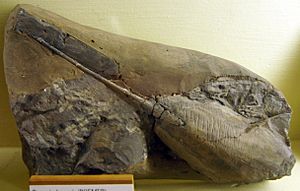Pteraspidiformes facts for kids
Quick facts for kids Pteraspidiformes |
|
|---|---|
 |
|
| Lamiaspis longiripa | |
| Scientific classification |
|
| Kingdom: | Animalia |
| Phylum: | Chordata |
| Superclass: | Agnatha |
| Class: | †Pteraspidomorphi |
| Subclass: | †Heterostraci |
| Order: | †Pteraspidiformes Berg 1940 |
| Suborders and families | |
|
|
Pteraspidiformes were an ancient group of fish that lived long ago. They are known from many fossils found mainly in Europe and North America. These fascinating creatures lived during the Devonian Period, and some even earlier in the Silurian Period.
Pteraspidiformes belong to a larger group called heterostraci, which were jawless fish covered in bony armor. Imagine a fish without a jaw, but with a tough, protective shell!
Amazing Anatomy: What They Looked Like
These ancient fish had their head and chest covered in strong armor. This armor was made of several bony plates. They had a plate on top (dorsal), one on the bottom (ventral), and special plates around their snout (rostral) and a small one near their "pineal gland" (pineal).
They also had a spine on their back, which was like a big, strong scale. Their tail was long and covered in smaller scales.
Some Pteraspidiformes lived on the ocean floor, like modern-day flatfish. They are called benthic creatures. Others were active swimmers, moving freely through the water. These are known as nekton.
Scientists believe that Pteraspidiformes were filter-feeders. This means they ate tiny bits of food, like plankton, by filtering water through their mouths. The delicate, finger-like parts near their mouth suggest they could pick out very specific sizes of plankton.
Different Kinds of Pteraspidiformes
Scientists group Pteraspidiformes into different families based on their features. Let's explore some of them!
Anchipteraspididae: The Oldest Known Group
The Anchipteraspidids are some of the oldest known Pteraspidiformes. Their fossils have been found in Canada and date back to the late Silurian Period.
Their armor might look a bit like another group of ancient fish called cyathaspidids. However, Anchipteraspidids already had the special plate arrangement that makes them true Pteraspidiformes.
Psammosteoidei: The Flattened Swimmers
Psammosteids are a group of Pteraspidiformes that often had very flattened bodies. Imagine a Pteraspidiformes that looks like it was squashed from top to bottom! They also had a long, flat tail.
Some psammosteids, like Pycnosteus, had a unique bottom shield that looked like a sled runner. This might have helped them glide along the seabed.
Psammosteids were special because they were the only heterostracans to survive past the Middle Devonian Period. However, they eventually died out during a big extinction event called the Kellwasser event in the Late Devonian.
Protopteraspididae: A Changing Group
The Protopteraspididae were once thought to be a simple, early family of Pteraspidiformes. But new studies show they were a diverse group. Their fossils show how Pteraspidiformes slowly changed over time. Some were very similar to the older Anchipteraspidids, while others were more like the later, more developed Pteraspidoidei.
Pteraspidoidei: The More Developed Forms
The Pteraspidoidei group includes the Pteraspidiformes that had more advanced features. Some of the Protopteraspidids also shared some traits with these more developed forms.
Pteraspididae: The Torpedo-Shaped Swimmers
The Pteraspididae family lived during the Early Devonian Period. This group includes the classic "torpedo-shaped" Pteraspidiformes, like Pteraspis. These fish are thought to have been fast, active swimmers in the water.
Their long, pointed snout (called a rostral plate) likely helped them cut through the water easily. Fossils of these fish have been found in both Europe and North America, in places that used to be oceans or river mouths.
Gigantaspididae: The "Hot Bun" Fish
Gigantaspididae is a small family with only one known genus, Gigantaspis. These fish lived in the Early Devonian seas around Svalbard (an island group north of Norway).
Species of Gigantaspis had armor that looked like a "hot bun" or a "round loaf of bread." They were similar in shape to some fish in the Protaspididae family.
Protaspididae: More Bun-Shaped Fish
The Protaspididae family also had bun or bread loaf-shaped armor. Their fossils have been found in the Rocky Mountains of the United States and in Europe.
Some members, like Xylaspis, looked a lot like Gigantaspis. Others, such as Protaspis, had more mound-shaped armor. There was even one, Psephaspis, that was very flat and was first thought to be a psammosteid!
Images for kids



